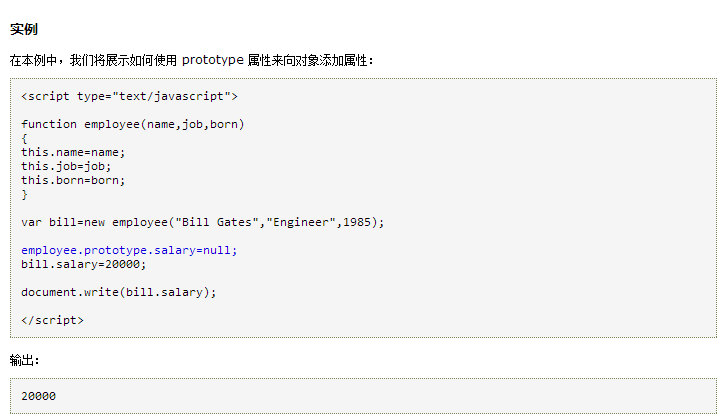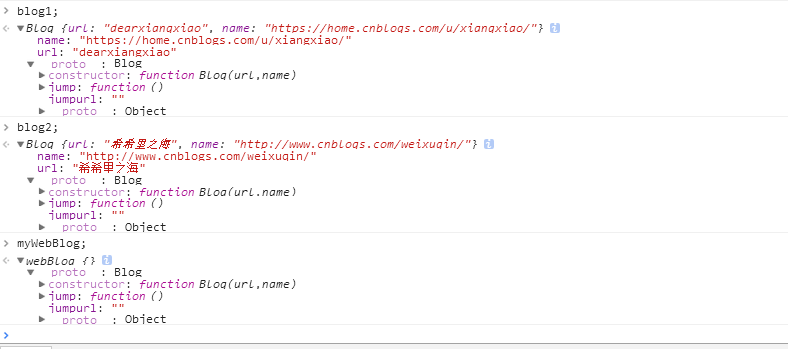js函数prototype属性学习(一)
W3school上针对prototype属性是这么给出定义和用法的:使您有能力向对象添加属性和方法。再看w3school上给的那个实例,如下图:

仔细一看,原来最基本的作用就是对某些对象的属性、方法来扩展,我对这个实例又多写了几句代码进行测试,如下:
var steve= new empolyee("Steve Jobs","enterpriser",1977);
这里我专门查看了steve这个实体所拥有的属性,发现多了一个salary属性,这个属性是新建实体时未曾定义的,可见由于prototype的作用,employee这个对象有了新的属性salary,那么,prototype到底是何方神圣,它在js对象里到底有着怎样不可或缺的作用呢?
javascript中的每个对象都有prototype属性,Javascript中对象的prototype属性的解释是:返回对象类型原型的引用。在javascript中并没有类的概念,但JavaScript中的确可以实现重载,多态,继承。这些实现其实方法都可以用JavaScript中的引用和变量作用域结合prototype来解释。原型法的主要思想是,现在有1个类A,我想要创建一个类B,这个类是以A为原型的,并且能进行扩展。我们称B的原型为A。
给人的感觉,A类就特别像java里的被继承的那个基础类,而B类继承后的实体子类,对B类的扩展就像多态,或者已有方法的重写,很面向对象有木有,这就是javascript带给我们最好的礼物,虽没有直接表明自己支持面向对象,但背地里却默默的支持着。再来看javascript的方法都有哪些种类。
1、类方法
var Person = {
};
Person.say = function(){
alert("I can say language");
};
2、对象方法
function Person(name){
this.name = name;
this.interduceSelf= function(){
alert("my name is " + this.name);
};
};
3、原型方法
Person.prototype.interduceSelfChinses = function(){
alert("我的名字是 " + this.name);
};
Person.say();
var person1 = new Person("xiaoming");
person1.interduceSelf(); //结果是my name is xiaoming
person1.interduceSelfChinses(); //结果是 我的名字是 xiaoming
var person2 = new Person("xiaozhang");
person2.interduceSelf(); //结果是my name is xiaozhang
person2.interduceSelfChinese(); //结果是 我的名字是 xiaozhang
由此我们可以看到,只要新增了一个对象的prototype属性中的方法,这个方法就成为了这对象的共有方法,不管你后来新建的是什么实体,都具有了这个共有方法,并且存在于它的_proto_属性里,如图:

可以看到,并没有对所有的人赋予新方法interduceSelfChinese,都自动的就有这个公共方法了,这是因为当一个对象被创建时,构造函数会把它的属性prototype赋给新对象的内部属性_proto_,这个_proto_属性被这个对象用来查找它的prototype属性,包括里面的属性、方法,都被查找出来,该调用时即调用。这样就有一个好处了,你不需要每次在构造一个对象的时候创建并初始化这个函数,继承就这样实现了,只不过严格的说,js并没提供继承这个概念,可以说新建的实体都是原来对象的一个拷贝,并且这个拷贝很活泛,可以重新写里面的属性和方法,同时还可以新增你想要的属性或方法,来看下面这个例子:
function FatherClass(){
this.class = "father";
this.setAuthority = function(){
this.authority = "controller";
};
};
var child = new function(){};
child.prototype = new FatherClass();
child.prototype.class = "child";
child.prototype.setAuthority = function(){
this.authority = "controlled";
};
child.say = function(){ //新增方法,直接针对新对象加上即可
alert("you can't controll me");
};
alert(child.class); //结果为child
alert(child.authority); //结果为controlled
child.say(); //结果为you can't controll me
从上面可以看出,函数式的编程还是博大精深的,这就是一门编程语言的艺术。同时,在外部不能通过prototype改变自定义类型的属性或方法。该例子可以看到:调用的属性和方法仍是最初定义的结果。即当原型方法和对象方法在调用相同的属性和函数时,会执行对象方法里面的属性和函数。再看下面的例子:
function FatherClass(){
this.class = "father";
this.setAuthority = function(){
this.authority = "controller";
};
};
FatherClass.prototype.class = "child";
FatherClass.prototype.setAuthority = function(){
this.authority = "controlled";
};
alert(FatherClass.class); //结果仍然为father
alert(FatherClass.authority); //结果仍然为controller
也就是说,不能直接通过prototype属性来修改对象本身以及有的属性、方法,要么新建一个拷贝它的实体再来修改,要么就新增属性或方法。
再来理解这2个东西,
1、A.prototype = new B();
2、A.prototype = B.prototype;
先来看A.prototype = new B(),理解prototype不应把它和继承混淆。A的prototype为B的一个实例,可以理解A将B中的方法和属性全部克隆了一遍。A能使用B的方法和属性。这里强调的是克隆而不是继承。可以出现这种情况:A的prototype是B的实例,同时B的prototype也是A的实例。
function baseClass(){
this.showMsg = function(){
alert("baseClass::showMsg");
}
} ;
function extendClass(){};
extendClass.prototype = new baseClass();
var instance = new extendClass();
instance.showMsg(); //结果是baseClass:showMsg
这里我们以baseClass的一个实例来做原型,来克隆的extendClass也同时包含了showMsg这个方法。extendClass.prototype = new baseClass()就可以阅读为:extendClass是以baseClass的一个实例为原型克隆创建的。但是当extendClass中有个与showMsg同名同参的函数时,调用这个函数会出现什么情况?再看这个例子:
function baseClass(){
this.showMsg = function(){
alert("baseClass:showMsg base");
}
};
function extendClass(){
this.showMsg = function(){
alert("extendClass:showMsg extend");
}
};
extendClass.prototype = new baseClass();
var extendA = new extendClass();
extendA.showMsg(); // 结果为extendClass:showMsg extend
从这里可以看出,函数运行时会先去本体的函数中去找,如果找到则运行,找不到则去prototype中寻找函数。或者可以理解为prototype不会克隆同名函数。如果要想直接调用原来类里的那个同名方法怎么办?可以用call()方法来实现,再写如下代码:
extendClass.prototype = new baseClass();
var instance = new extendClass();
var baseinstance = new baseClass();
baseinstance.showMsg.call(instance); //结果是baseClass::showMsg base
这里的baseinstance.showMsg.call(instance);阅读为“将instance当做baseinstance来调用,调用它的对象方法showMsg”
再看A.prototype = B.prototype,A的prototype为B的prototype,可以理解A将B的prototype中方法和属性全部克隆了一遍。A能使用B的prototype方法和属性。这里强调的也是克隆而不是继承。请看下面一个例子:
function Blog(url,name){
this.url = url;
this.name = name;
};
Blog.prototype.jumpurl = '';
Blog.prototype.jump = function(){
window.location = this.jumpurl;
};
var blog1 = new Blog('dearxiangxiao', 'https://home.cnblogs.com/u/xiangxiao/');
var blog2 = new Blog('希希里之海', 'http://www.cnblogs.com/weixuqin/');
var webBlog = function(){};
webBlog.prototype = Blog.prototype;
var myWebBlog = new webBlog();

从上面的执行结果可以看出,myWebBlog的两个属性jump和jumpUrl分别引用了Blog.prototype.jumpurl和Blog.prototype.jump,由此可见,对象的prototype也可作为另一个对象的prototype的引用。
结束语:感觉js里面对类和实体对象对于方法的声明并无多大讲究,类方法也可直接拿来用,要知道,在java里可必须是抽象方法才允许这么调用的。






